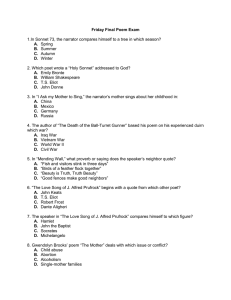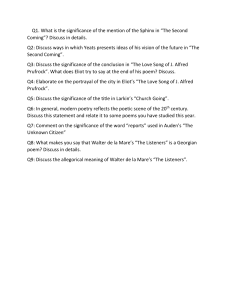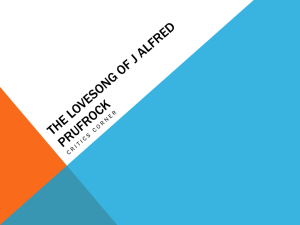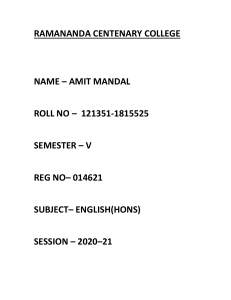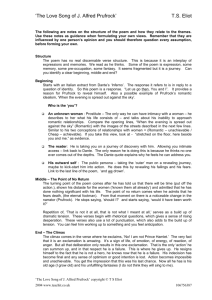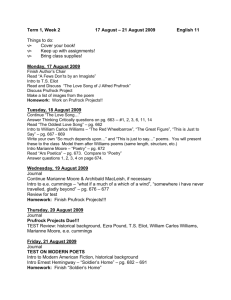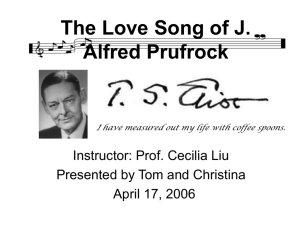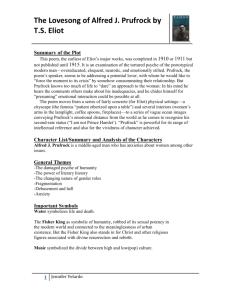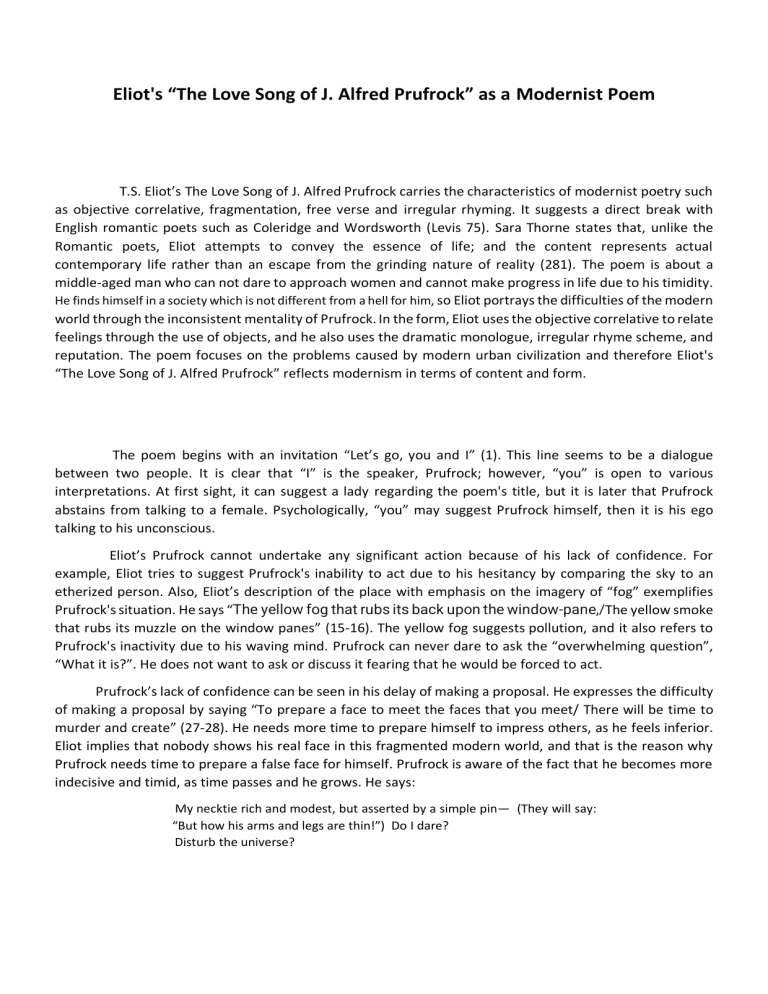
Eliot's “The Love Song of J. Alfred Prufrock” as a Modernist Poem T.S. Eliot’s The Love Song of J. Alfred Prufrock carries the characteristics of modernist poetry such as objective correlative, fragmentation, free verse and irregular rhyming. It suggests a direct break with English romantic poets such as Coleridge and Wordsworth (Levis 75). Sara Thorne states that, unlike the Romantic poets, Eliot attempts to convey the essence of life; and the content represents actual contemporary life rather than an escape from the grinding nature of reality (281). The poem is about a middle-aged man who can not dare to approach women and cannot make progress in life due to his timidity. He finds himself in a society which is not different from a hell for him, so Eliot portrays the difficulties of the modern world through the inconsistent mentality of Prufrock. In the form, Eliot uses the objective correlative to relate feelings through the use of objects, and he also uses the dramatic monologue, irregular rhyme scheme, and reputation. The poem focuses on the problems caused by modern urban civilization and therefore Eliot's “The Love Song of J. Alfred Prufrock” reflects modernism in terms of content and form. The poem begins with an invitation “Let’s go, you and I” (1). This line seems to be a dialogue between two people. It is clear that “I” is the speaker, Prufrock; however, “you” is open to various interpretations. At first sight, it can suggest a lady regarding the poem's title, but it is later that Prufrock abstains from talking to a female. Psychologically, “you” may suggest Prufrock himself, then it is his ego talking to his unconscious. Eliot’s Prufrock cannot undertake any significant action because of his lack of confidence. For example, Eliot tries to suggest Prufrock's inability to act due to his hesitancy by comparing the sky to an etherized person. Also, Eliot’s description of the place with emphasis on the imagery of “fog” exemplifies Prufrock's situation. He says “The yellow fog that rubs its back upon the window-pane,/The yellow smoke that rubs its muzzle on the window panes” (15-16). The yellow fog suggests pollution, and it also refers to Prufrock's inactivity due to his waving mind. Prufrock can never dare to ask the “overwhelming question”, “What it is?”. He does not want to ask or discuss it fearing that he would be forced to act. Prufrock’s lack of confidence can be seen in his delay of making a proposal. He expresses the difficulty of making a proposal by saying “To prepare a face to meet the faces that you meet/ There will be time to murder and create” (27-28). He needs more time to prepare himself to impress others, as he feels inferior. Eliot implies that nobody shows his real face in this fragmented modern world, and that is the reason why Prufrock needs time to prepare a false face for himself. Prufrock is aware of the fact that he becomes more indecisive and timid, as time passes and he grows. He says: My necktie rich and modest, but asserted by a simple pin— (They will say: “But how his arms and legs are thin!”) Do I dare? Disturb the universe? In a minute there is time For decisions and revisions which a minute will reverse (43-48). The parenthesis in the above quotation reflects Prufrock’s anxiety about the public opinion. In other words, he is worried about how his appearance will be evaluated by others. Besides its modern content, the form of “The Love Song of J. Alfred Prufrock” also reflects the characteristics of modernist poetry. Eliot was influenced by the French symbolists, who thought that one will not be able “to use conventional language to convey sensations as we actually experience them” (Throne 279). Eliot believes that poets should look for a way to express the emotion implicitly and he sees objective correlative as a solution. Objective correlative, he says, “is a set of objects, a situation, a chain of events which shall be the formula of that particular emotion” (qtd, in Throne 282). Eliot uses characters like Prufrock to mask himself in order to be objective. Each symbol in his poetry represents certain emotions. Eliot’s imagery of the city with “half-deserted streets” (4), “cheap hotels” (6), and “sawdust restaurants” (7) refer to the corruption of city life while “yellow fog” (15) is an objective correlative for Prufrock’s inactivity and laziness. Also, Eliot’s use of figurative language reflects the fragmented modern world. For example, he talks about humanity through the synecdoche of certain body parts such as faces, hands, voices, eyes, and arms. Throne states that referring “to detached body parts intensifies the loss of humanity by reducing individuals to fragments.” Such a literary device implies that people, in the modern world, are isolated from each other just like their body parts. Moreover, Eliot uses an irregular rhyme scheme and this can be seen as a result of disorder in modern society. The number of words in lines varies. For instance, lines 45-46 “ Do I dare/ Disturb the universe,” consist of three words while other lines consist of more than ten words, “ Through I have seen my head ( grown slightly bald ) brought in upon a platter.”(82) This shows how modernist poets breakaway from the traditional form of the poem which involves meter and rhyme. There are also lots of fragmented sentences such as “And time yet for a hundred indecisions, / And for a hundred visions and revisions, / Before the taking of a toast and tea.” (32-34). The fragmentation obvious in these lines can be associated with the inconsistency of modern life. Eliot repeats some sentences within the same line intentionally to reflect Prufrock’s problem with the modern society as well as himself. For example, the repetitions in lines “There will be time, there will be time” (26), “To wonder, “Do I dare?” and, “Do I dare?” (38) or “I grow old [...] I grow old [...]” (122) underline “the tedium of the chic but superficial world Prufrock inhabits” (Bloom 17). Actually, these lines may also refer to Prufrock’s routine and boring life which he is fed up with. In addition to fragmented sentences, the unequal number of lines and variable speech rhythms reflect the chaos in 20th century society. In conclusion, Eliot's "The Love Song of J. Alfred Prufrock" embodies the elements of modernist poetry in both its content and form . Through techniques like objective correlative, fragmentation, free verse, and irregular rhymes, Eliot portrays a vivid picture of the challenges of the modern society. Prufrock's character embodies the modern dilemma of hesitation, insecurity, and isolation in the face of urban civilization. Eliot's choice of imagery, such as the "yellow fog" and the depiction of fragmented body parts, serves as a mirror to the fragmented nature of contemporary society. The use of irregular rhyme schemes and fragmented sentences reinforces the disorder and inconsistency of the modern era. By merging these aspects of modernism, Eliot effectively conveys the struggles and anxieties of his time, making "The Love Song of J. Alfred Prufrock" a poignant reflection of both form and content within the modernist movement. References Eliot, T. S. “The Love Song of J. Alfred Prufrock.” T.S Eliot: Collected Poems 1909-1962. New York: Harcourt Inc., 1963. Bloom, Harold. T .S., Eliot: Bloom’s Major Poets. Pennsylvania: Chelsea House Publisher, 1999. F. R. Leavis. New Bearings in English Poetry. London: Chat to and Winds, 1961. Thorne, Sara. Mastering Poetry. New York: Palgrave Macmillan, 2006.
